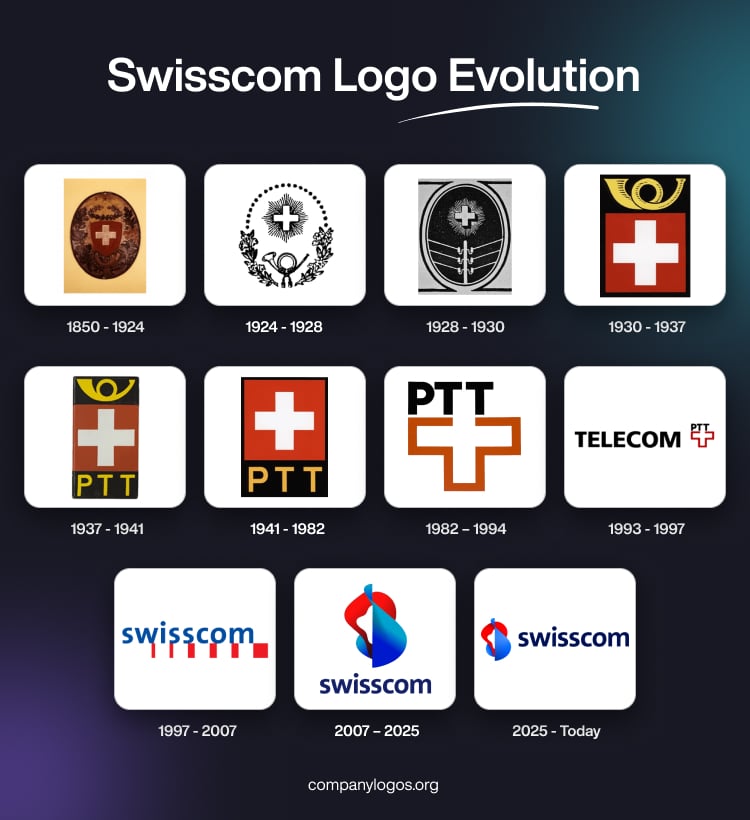
Swisscom AG is the leading provider of telecommunications services in Switzerland and is one of the largest in Europe. Founded at the end of the 1990s as a successor of Postal Telegraph and Telephone, or PTT, it claims to own 60% of the market share in mobile services and 67% for broadband.
The logo of Swisscom reflects the technological progress made by the company and its transformation from a state-run service to a modern digital innovator. The logo evolution is a story of adaptation, modernisation, and the pursuit of relevance in an ever-changing communications landscape. The article delves into the evolution of the Swisscom logo, among other details of the company.
The Genesis of the Swisscom Logo (1850 – 1924)
The roots of Swisscom can be traced back to the Swiss postal, telegraph, and telephone services (PTT). The original logo designed in 1850 featured a red shield with a golden cross surrounded by intricate drawings, laurel leaves, a horn, ornate elements, and a five-pointed star. These elements were placed inside an oval and set against a cream-coloured vertical rectangle as the backdrop.

(1924 – 1928)
The 1924 logo was a rehash of the previous logo. The simplified logo in monochrome had many of the ornate details removed. The laurel leaves, cross, and horn were retained, and the cross was surrounded by a halo.
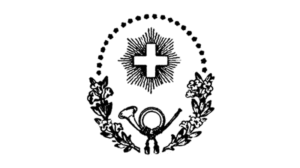
(1928 – 1930)
In 1928, a modernised version of the logo was introduced. It had telegraph poles with wires in off-white colour replacing the horn. Although the cross and the halo were retained, the laurel leaves were removed. The elements were set against a black oval backdrop with two outlines. The oval was further placed within a vertical rectangle in grey, and there were thick black lines at the top and bottom of the rectangle meeting the thick outer edge of the oval.
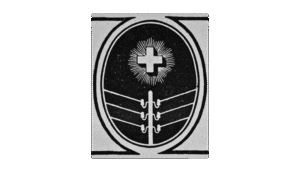
(1930 – 1937)
The 1930 logo had a geometric appearance. It had a wide pure white cross placed inside a red square. The same was further placed within a larger black vertical rectangle. At the top of the red square appeared the golden-coloured horn with slight black accents. Interestingly, this logo was used by the postal division, while the telegraph or telephone division used the logo with the telegraph pole.
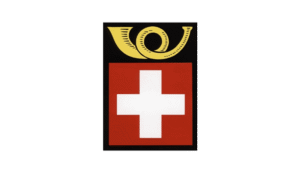
(1937 – 1941)
In 1937, the logo saw the addition of the acronym “PTT” to mark the unification of the three services. So, the previous logo was redesigned by including the acronym “PTT” at the bottom of the black but rather slender vertical rectangle. The slight black accents to the golden horn were removed to make the overall logo minimalist.
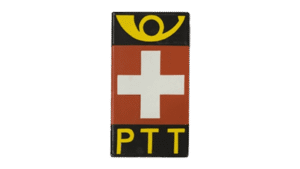
(1941 – 1982)
In the 1941 logo, the golden horn was dropped, and the logo focused on the national insignia of Switzerland and the “PTT” acronym.
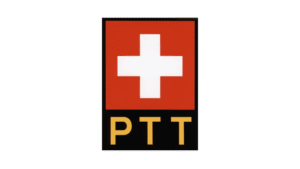
(1982 – 1994)
The 1982 logo variant brought a contemporary graphic style. Here, the redesigned logo played with the Swiss cross and the PTT acronym to reflect a more modern and streamlined organisation. Designed by Martin Altenburger and Adrian Frutiger, the logo dropped the black and red geometric figures. In their place was seen a white cross with a thick red border. The top part of the cross was completed by the two “Ts” from the acronym “PTT” in black.
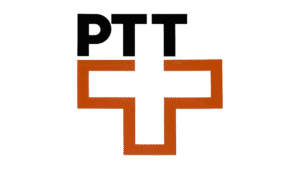
Another variant of the logo with a bright yellow background was also designed during the period.
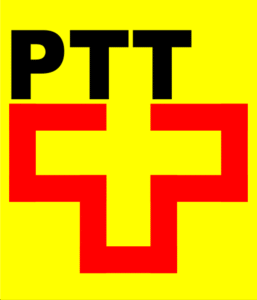
(1993 – 1997)
In the early 1990s, the telecommunications division of the company was separated from the postal services division to form two entities – Telecom PTT (later Swisscom) and Swiss Post. As a result, the 1993 logo saw the addition of the word “Telecom” in thick, bold, uppercase and written in a Frutiger typeface to the previous logo design. This symbolised the company’s growing focus on digital communications and innovation.
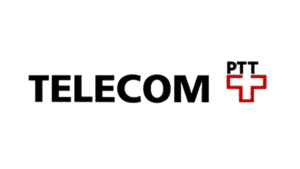
(1997 – 2007)
In 1997, the telecom division was privatised and rebranded as Swisscom. The new logo featured the new name in blue lowercase. Below the new name “Swisscom” were placed several red vertical rectangles of increasing thickness to form a dynamic pattern. The design balanced the human side of technology with the reliability expected from a traditional Swiss company.
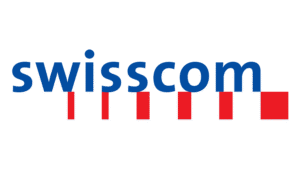
(2007 – 2025)
In December 2007, Swisscom announced a major rebranding exercise. It consolidated the various sub-brands (Fixnet, Mobile, Solutions, Bluewin) under a single, unified Swisscom brand. The new logo was a significant departure from previous designs. It featured a dynamic, three-dimensional emblem with blue, red, and purple tones to symbolise solidarity, innovation, and digital transformation.
The new logo emblem appeared to be inspired by the human cardiovascular system. It embodied the idea of continuous dialogue and connection with customers, employees, and partners and reflected the company’s shift toward a multimedia, digital future.

(2025 – Today)
The latest Swisscom logo retained the idea and style of the previous version while making it more confident and attractive. The colours of the emblem were made brighter, and the emblem itself was placed to the left of the brand name in lowercase.

The Elements of the Swisscom Logo
Font
The lowercase wordmark of the Swisscom logo uses a custom, modern sans-serif typeface. The typeface is characterised by rounded lines for most letters, except for “w”, which retains sharper angles. This choice of typeface reflects Swisscom’s commitment to innovation and accessibility.
Colour
The Swisscom logo employs a blend of blue, red, and purple colours. The blue colour symbolises trust, reliability, and technological expertise. The red colour represents warmth, passion, and the Swiss national identity. And finally, the purple colour adds a modern, innovative twist to the palette. It reflects creativity and digital transformation.
The History of Swisscom
The history of Swisscom dates back to the early development of Switzerland’s telecommunication infrastructure. It began with the establishment of the first telegraph network in 1852 and the introduction of telephones in 1877. In 1920, postal, telegraph, and telephone services were unified under a single state-controlled entity known as the Postal Telegraph and Telephone (PTT). The PTT was a pioneer in several areas, for it made Switzerland the first country to have a fully automated telephone exchange system in 1959. It also launched the first NATEL mobile telephone system fortress in 1978.
The 1980s and 1990s marked a period of rapid modernisation for Swiss telecommunications. It included the introduction of digital networks and the launch of the NATEL D mobile network in 1993. As the Swiss government began deregulating the sector in the early 1990s, Telecom PTT was transformed into Swisscom in 1997. A year later, Swisscom was listed on the Swiss Stock Exchange, thereby transitioning from a state monopoly to a publicly traded company. However, the government still held a majority stake.
Swisscom then embarked on a phase of expansion and innovation. It acquired Germany’s Debitel AG in 1999 and a majority stake in Italy’s Fastweb in 2007. It thus strengthened its presence in the European market. The company continued to invest in cutting-edge technology. It did so by rolling out DSL broadband in the early 2000s, launching IPTV in 2006, and introducing commercial 5G services in 2019. In fact, it made Swisscom the first operator to offer 5G in Europe. Domestically, Swisscom consolidated its brand by merging sub-brands and launching new services under the main Swisscom identity.
In recent years, Swisscom has continued to grow, especially by acquiring Vodafone Italia in 2024. It merged Vodafone Italia with Fastweb to create a major telecommunications provider in Italy under the Fastweb + Vodafone brand. The Swiss government still holds a majority stake in the company, and while discussions about further privatisation continue, most Swiss voters currently oppose a full sale of the government’s share.
Today, Swisscom stands as Switzerland’s leading telecommunications company. It is recognised for its innovation, sustainability, and commitment to advancing the country’s digital infrastructure and services.
Interesting Facts About Swisscom
- Swisscom is the market leader in mobile, internet, and digital TV services in Switzerland. It also holds a strong position in the Italian market through Fastweb + Vodafone.
- The company has been recognised as the most sustainable telecommunications service provider in the world. It earned this title multiple times, including three consecutive years, from World Finance Magazine.
- Swisscom aims to become completely climate neutral across its entire value chain by 2025. It has already reduced its direct emissions by over 85% since 1990.
- The company uses 100% renewable energy. It operates an emissions-free vehicle fleet and has integrated post-consumer recycled plastics in its own-brand products. These include making its WLAN-Box 3 from 70% recycled materials.
- Swisscom is a pioneer in digital literacy. It offers the Swisscom Campus online hub with courses and resources to help people of all ages use digital media safely and effectively.
- It operates the largest critical digital infrastructure in Switzerland and is a leader in cybersecurity services for businesses.
- Swisscom has received numerous awards for its network quality and sustainability. It is also known as one of Switzerland’s most attractive employers.
- The company introduced IPTV in 2006 and launched its next-generation Swisscom TV 2.0 in 2014, which supports seamless multi-device experiences.
- Headquartered in Ittigen near Bern, Swisscom has a proud heritage dating back to the Swiss Postal Telegraph & Telephone (PTT) of 1852.
- Swisscom is committed to innovation. It has been the first European provider to launch fibre to the street (FTTS) internet service and is investing heavily in cloud, IoT, and digital health solutions.
Finally
The logo history of Swisscom is about following the trends in graphic design and visually chronicling Swiss telecommunications. It has adapted to new eras, technologies, and customer expectations while staying rooted in Swiss values and trust.